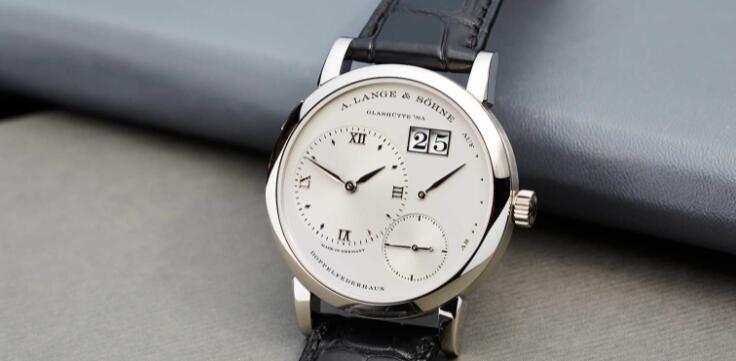When it was first unveiled in 1994, no one had seen a watch quite like the Lange 1, with its distinct, geometrically harmonious dial. In subsequent years, the Lange 1 came to define the German brand’s pure aesthetic and impeccable technical pedigree. A resolutely contemporary looking watch, it might be surprising to learn that its roots were far from modern. In fact, it dates back to 1841, when Ferdinand A. Lange completed an innovative digital five minute clock for the Semper Opera House in Dresden. It was this historic clock that served as the muse serves as the inspiration for the Lange 1’s distinctive large date complication. The watch recently underwent an upgrade, and here’s what we think.
One of the most distinctive in the business, the A. Lange & Söhne Lange 1 dial is a deconstructed assemblage of date, power reserve, seconds and time. In theory, all this should make it cluttered and complicated, but thanks to the brand’s respect for good design based on the mathematical principles of the Golden Ratio, the dial is very balanced It’s also very German – a model of sober restraint expressed in shades of grey.
This is the bigger picture, but as you’d expect from Lange, the dial more than holds up under close examination. The text is well spaced, and the 2015 version sees the A. Lange & Söhne Lange 1 name expressed in a slightly more delicate type. (Having said that, it’s a touch counterintuitive that the only English on the dial is ‘Made in Germany’.) The other point that demonstrates Lange’s attention to detail is the repetition of the triangle motif – most notable on the power reserve (Ab/Auf) indicator, but also on the main dial’s diamond indices and the counterweight on the seconds hand.
As with the dial, the apparent simplicity of the 38.5mm case belies its complexity. While the bezel (which has been slimmed down in this update) is polished, the middle section is brushed, creating a much more casual look in the solid platinum case. The lugs are actually screwed on, which means they can be removed when refinishing the case – a clever touch most wouldn’t bother with. With a very few exceptions, Lange only make watches in precious metals and, while it’s the priciest, this platinum version is arguably the most versatile. It’s harder than gold, which means less likely to mark, and it’s more lustrous. One more fact that shows just how high Lange set their standards is that any precious case that becomes scratched and needs refinishing will have those blemishes filled with new metal, so that the weight of your watch remains the same. Now that’s service.
You could make a pretty solid argument that the correct way to wear the A. Lange & Söhne Lange 1 is with the movement facing out. There’s just so much to see, which is a little surprising given that most of its movements are hidden behind the traditionally German three quarter plate. But the plate is stunning in its own right, in nickel silver (which will achieve a patina with age) with Glashütte ribbing, jewels set in gold chatons and hand blued screws. Then of course there’s the hand engraved balance cock – a hallmark of Lange’s quality. Even though the Lange 1 dates back to 1994, the L121.1 movement in the 2015 update is completely new. The balance wheel is larger, and features a new balance wheel and in-house hairspring. The movement, too, boasts numerous improvements. For example, the large date now changes instantaneously at midnight, and when the power reserve runs down, the seconds hand stops automatically at zero, allowing for greater accuracy when resetting the time. Lange have also added an improved escapement with an in-house hairspring. All small changes, but they add up.
In a word: heavy. Seriously, thanks to the heft you won’t ever forget you’re wearing a platinum watch. And that’s not a bad thing considering how clean and considered this watch is. It’s pretty close to perfection. Having said that, the design of the Lange 1, which verges on the austere is one of their more polarising offerings. Unlike their crowd-pleasing Datograph, the Lange 1, with its contemporary/classic dial layout is more of an acquired taste. It’s a sophisticated watch for sophisticated tastes.
A. Lange & Söhne Lange 1
